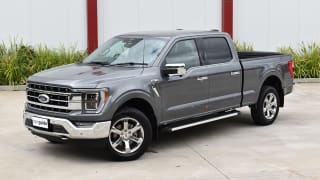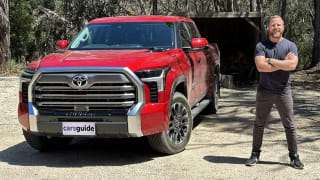If this was a review of the mid-range 1500 Laramie, the score would read 8/10 for value. But for all its great points, the Big Horn halves that, despite being essentially the same package and cheaper.
Confused? Keep reading, because you’ll need to know the broader brand backstory to fully understand what’s going on and why.
Originating in North America as an F-Series-fighting Dodge by Chrysler in 1981, Ram became a stand-alone marque in 2010. Local sales commenced in 2015, using US-sourced but Australian RHD conversion knowhow by American Special Vehicles (ASV, and part-owned by Walkinshaw Automotive Group at the time), first with the 2500 and 3500 heavy-duty trucks, before their volume-selling 1500 sibling changed buying habits from mid-2018.
Luring Ford Ranger Wildtrak and Raptor buyers away with pricing that kicked off from just $79,950 drive-away, the base 1500 Express helped prise open the full-sized ute market with power and swagger – if not much swag.

But this was with the 2008-vintage old-shape Ram DS series, which by 2020 was in its twilight years, so a few missing bits and pieces was okay. The far-more advanced DT successor promised better. But an equally-low price wasn't one of them.
By late 2023, the DS 1500 Express Quad Cab made way for the longer-bodied and more-highly specified DT 1500 Big Horn Crew Cab, and started from a lofty $119,950 (all prices quoted from here on are before on-road costs).
This represents a $34K jump (or $21K if matched body-for-body length) over the old ute.
Now, the good news is that there are night-and-day differences between old and new-gen Rams to help justify the price gap.
Despite similar proportions, the DT is a complete redesign inside, outside and (mostly) underneath, and is over 100kg lighter yet stronger, partly due to aluminium used for the bonnet and tailgate, amongst other areas.

As before, the Ram features coil-sprung rear suspension instead of truck-style leaf springs like most rivals, as well as – until 2025’s Series II facelift lands – Chrysler’s fantastic Hemi V8.
Looking at the spec sheet, there's also a lot to appreciate.
Buying Big Horn brings you 4WD, lovely cloth upholstery, heating for the front seats and steering wheel, push-button start, an 8.4-inch touchscreen, an advanced multimedia interface with wireless Apple CarPlay and Android Auto, a rear-view camera, front and rear parking sensors, cruise control, remote central locking, five USB ports (three As and two Cs), heated/powered folding exterior mirrors, rear privacy glass, an electrically sliding back window, a rear bedliner, retractable bed step, tie-down points and 18-inch alloy wheels.

Plus, there’s a choice of a 1700mm (five-feet/seven-inch or 5’7”) or 1930mm (6’4”) extended rear tub for only $1000 extra, as tested. Great for dirt bikes, apparently.
But here’s where things become unstuck for the Big Horn.
While you do get airbags (dual front, front-side and front/rear curtain items), trailer sway control, hill-start assist and stability/traction controls for your $120K, the cheapest 1500 is woefully under-equipped, losing equipment you’d expect in any truck costing half as much.
These include important safety omissions such as Autonomous Emergency Braking (AEB), blind-spot alert, lane-keep systems and LED headlights with auto high beams.
Furthermore, on the convenience front, items like adaptive cruise control, keyless entry, a driver’s seat lumbar support, front-seat height adjustment, climate control for the air-con, a head-up display, digital radio, satellite navigation, wireless smartphone charging, rain-sensing wipers and a 12-volt outlet in the tub are missing.

These are disappointing spec gaps that seriously undermine the Big Horn’s value. Hence our 4/10 score in this department. The Silverado 1500 LTZ Premium (from $130,500) only costs about $10K extra, but is embarrassingly more-richly equipped, while the more-basic F-150 XLT at least starts from just $106,950 and still manages to include AEB and other driver-assist safety features.
Seriously, lose the heated seats/steering wheel, glossy alloys, retractable mirrors and opening rear window. Safety shouldn't be compromised.
Which brings us to the 8/10-for-value Ram 1500 Laramie, from $137,950.
This is the grade to get for most of the Big Horn's missing safety and convenience gear, plus luxuries including leather, a sunroof, powered front seats, heated rear seats, electric side steps, a 35 per cent larger touchscreen, 19-speaker Harman Kardon audio, a 360-degree camera view, adjustable pedals and 20-inch alloys to help justify the extra $18K. And you’ll need the $140K-plus F-150 Lariat for comparable Ford spec.
Of course, people can easily, even happily, live without most of the lost items, as we did during our Big Horn adventure, but the absent safety tech can be the difference between having and avoiding an accident.
Thus, we hesitate in recommending the base 1500 unless you're completely okay with reduced kit, but resoundingly endorse the Laramie, because from here on in the Ram meets and often exceeds expectations.























